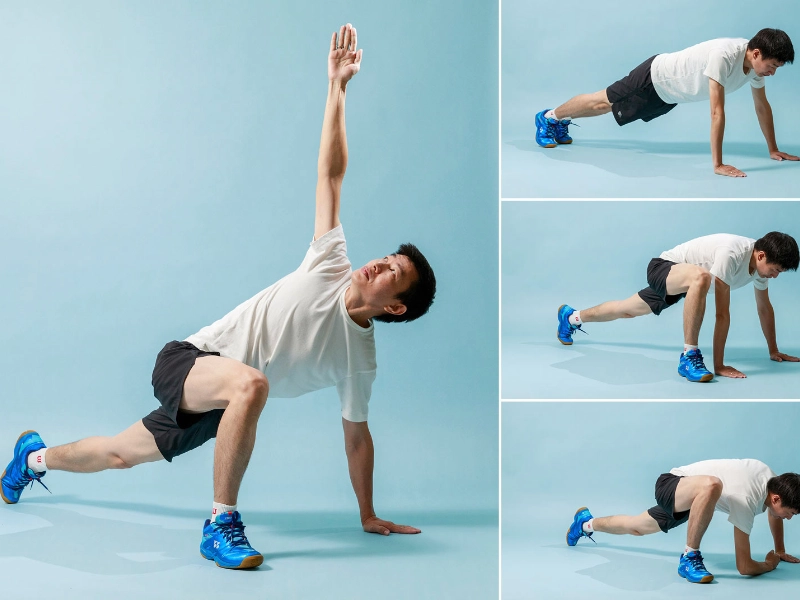Gym-Specific Stretching Routines: Flexibility For Fitness
Any exercise program depends critically on stretching. Neglect can cause a range of problems from tight muscles to delayed-onset muscular soreness (DOMS). Both active and static stretching should be part of your gym sessions. While static stretches assist the muscles relax following exercise, dynamic stretches warm up and ready the muscles for use.
Dynamic Reversals

Passive Stretches
 Most people's conception of exercise is based on the component that increases heart rate. They see themselves lost in the delight of a long run out in nature or clipped into their Peloton bike. Still, the value of stretching goes beyond just your heart rate rising.
Static stretches have a longer hold in the stretched posture than dynamic stretches. Often included as a cool-down after exercise, static stretches assist the muscles return to normal while also strengthening flexibility and range of motion.
For a stretch Kumar suggests, for instance, stand with your legs hip-width apart and raise one knee towards your belly button. To get hip flexor flexibility, repeat this on both sides.
Although you would believe that the best approach to get your blood flowing is to start a hard activity straight after a long day, doing so could cause muscular harm. This is thus since your muscles are tight from lack of movement and will be unprepared for the rigorous exercise coming forward.
Most people's conception of exercise is based on the component that increases heart rate. They see themselves lost in the delight of a long run out in nature or clipped into their Peloton bike. Still, the value of stretching goes beyond just your heart rate rising.
Static stretches have a longer hold in the stretched posture than dynamic stretches. Often included as a cool-down after exercise, static stretches assist the muscles return to normal while also strengthening flexibility and range of motion.
For a stretch Kumar suggests, for instance, stand with your legs hip-width apart and raise one knee towards your belly button. To get hip flexor flexibility, repeat this on both sides.
Although you would believe that the best approach to get your blood flowing is to start a hard activity straight after a long day, doing so could cause muscular harm. This is thus since your muscles are tight from lack of movement and will be unprepared for the rigorous exercise coming forward.
Stretches following exercise
 Stretching is a key component of your exercise regimen whether your goals are to run a marathon, finish your first cycling class, or simply keep up with your energetic children. Though it's not the most interesting component of your exercise, it's a necessary step in reaching your objectives and maintaining injury-free.
Although you can do static stretches whenever you choose, they are particularly helpful for aiding in bodily recovery following exercise. In addition to improving your range of motion and flexibility, stretching following an exercise helps lessen delayed-onset muscular pain.
Always keep in mind breathing properly and hold the stretch for 10 to 30 seconds. While a minor pulling sensation is normal, stop and relax if your muscles or joints hurt strongly or sharply.
Stretching is a key component of your exercise regimen whether your goals are to run a marathon, finish your first cycling class, or simply keep up with your energetic children. Though it's not the most interesting component of your exercise, it's a necessary step in reaching your objectives and maintaining injury-free.
Although you can do static stretches whenever you choose, they are particularly helpful for aiding in bodily recovery following exercise. In addition to improving your range of motion and flexibility, stretching following an exercise helps lessen delayed-onset muscular pain.
Always keep in mind breathing properly and hold the stretch for 10 to 30 seconds. While a minor pulling sensation is normal, stop and relax if your muscles or joints hurt strongly or sharply.
Guidelines for Flexibility
 Among the several problems tight muscles can cause are joint pain and higher chance of injury. Dynamic stretches either during the day or as part of your warm-up can help to keep you flexible and lower stiffness. Though it should feel fantastic, always be cautious not to push yourself too far into a stretch as it should not hurt. If a stretch hurts too much, the brain signals that something is wrong and the muscle will tense in a defensive reaction, therefore raising the likelihood of damage.
Although many people are time-pressed and routinely forgo stretching before and after exercises, the effort can greatly affect your muscles and joints. Enhancing flexibility will help you to move your body more precisely and raise the workout intensity. Maintaining flexible muscles will help you to enhance performance over time and lower your risk of injury. Try for symmetry; ensure you are equally flexible on both sides of your body.
Among the several problems tight muscles can cause are joint pain and higher chance of injury. Dynamic stretches either during the day or as part of your warm-up can help to keep you flexible and lower stiffness. Though it should feel fantastic, always be cautious not to push yourself too far into a stretch as it should not hurt. If a stretch hurts too much, the brain signals that something is wrong and the muscle will tense in a defensive reaction, therefore raising the likelihood of damage.
Although many people are time-pressed and routinely forgo stretching before and after exercises, the effort can greatly affect your muscles and joints. Enhancing flexibility will help you to move your body more precisely and raise the workout intensity. Maintaining flexible muscles will help you to enhance performance over time and lower your risk of injury. Try for symmetry; ensure you are equally flexible on both sides of your body.









